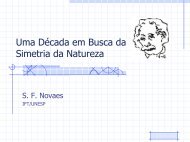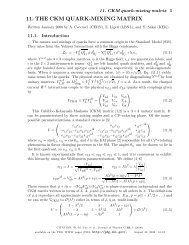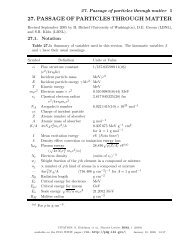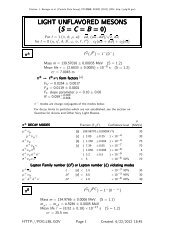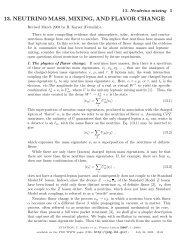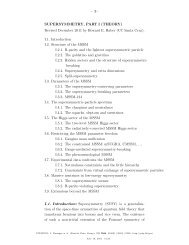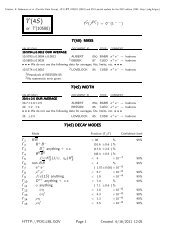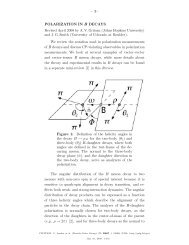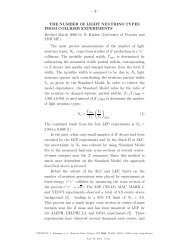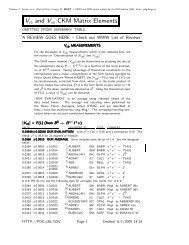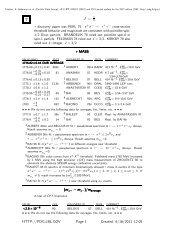– 1– , Vus, THE CABIBBO ANGLE, AND CKM UNITARITY Updated ...
– 1– , Vus, THE CABIBBO ANGLE, AND CKM UNITARITY Updated ...
– 1– , Vus, THE CABIBBO ANGLE, AND CKM UNITARITY Updated ...
You also want an ePaper? Increase the reach of your titles
YUMPU automatically turns print PDFs into web optimized ePapers that Google loves.
<strong>–</strong>1<strong>–</strong><br />
V ud , V us , <strong>THE</strong> <strong>CABIBBO</strong> <strong>ANGLE</strong>,<br />
<strong>AND</strong> <strong>CKM</strong> <strong>UNITARITY</strong><br />
<strong>Updated</strong> November 2007 by E. Blucher (Univ. of Chicago) and<br />
W.J. Marciano (BNL)<br />
The Cabibbo-Kobayashi-Maskawa (<strong>CKM</strong>) [1,2] threegeneration<br />
quark mixing matrix written in terms of the Wolfenstein<br />
parameters (λ, A, ρ, η) [3] nicely illustrates the orthonormality<br />
constraint of unitarity and central role played by λ.<br />
⎛<br />
V <strong>CKM</strong> = ⎝ V ⎞<br />
ud V us V ub<br />
V cd V cs V cb<br />
⎠<br />
V td V ts V tb<br />
⎛<br />
= ⎝ 1 − λ2 /2 λ Aλ 3 ⎞<br />
(ρ − iη)<br />
−λ 1 − λ 2 /2 Aλ 2 ⎠+O(λ 4 ) . (1)<br />
Aλ 3 (1 − ρ − iη) −Aλ 2 1<br />
That cornerstone is a carryover from the two-generation Cabibbo<br />
angle, λ =sin(θ Cabibbo )=V us . Its value is a critical ingredient<br />
in determinations of the other parameters and in tests of <strong>CKM</strong><br />
unitarity.<br />
Unfortunately, the precise value of λ has been somewhat<br />
controversial in the past, with kaon decays suggesting [4] λ ≃<br />
0.220, while hyperon decays [5] and indirect determinations via<br />
nuclear β-decays imply a somewhat larger λ ≃ 0.225 − 0.230.<br />
That discrepancy is often discussed in terms of a deviation from<br />
the unitarity requirement<br />
|V ud | 2 + |V us | 2 + |V ub | 2 =1. (2)<br />
For many years, using a value of V us derived from K → πeν<br />
(K e3 ) decays, that sum was consistently 2<strong>–</strong>2.5 sigma below<br />
unity, a potential signal [6] for new physics effects. Below, we<br />
discuss the current status of V ud , V us , and their associated<br />
unitarity test in Eq. (2). (Since |V ub | 2 ≃ 1 × 10 −5 is negligibly<br />
small, it is ignored in this discussion.)<br />
V ud<br />
The value of V ud has been obtained from superallowed<br />
nuclear, neutron, and pion decays. Currently, the most precise<br />
CITATION: W.-M. Yao et al.<br />
(Particle Data Group), J. Phys. G 33, 1 (2006) and 2007 partial update for edition 2008 (URL: http://pdg.lbl.gov)<br />
November 29, 2007 15:00
<strong>–</strong>2<strong>–</strong><br />
determination of V ud comes from superallowed nuclear betadecays<br />
[6] (0 + → 0 + transitions). Measuring their half-lives, t,<br />
and Q values which give the decay rate factor, f, leadstoa<br />
precise determination of V ud via the master formula [7<strong>–</strong>9]<br />
|V ud | 2 =<br />
2984.48(5) sec<br />
ft(1 + RC)<br />
(3)<br />
where RC denotes the entire effect of electroweak radiative<br />
corrections, nuclear structure, and isospin violating nuclear<br />
effects. RC is nucleus-dependent, ranging from about +3.0%<br />
to +3.6% for the nine best measured superallowed decays. In<br />
Table1,wegiveupdated[10]ft values along with their implied<br />
V ud for the nine best measured superallowed decays [6, 10].<br />
They collectively give a weighted average (with errors combined<br />
in quadrature) of<br />
V ud =0.97418(27) (superallowed) , (4)<br />
which, assuming unitarity, corresponds to λ =0.226(1). We<br />
note that the new average value of V ud is shifted upward compared<br />
to our 2005 value of 0.97377(27) primarily because of a<br />
recent reevaluation of the isospin breaking Coulomb corrections<br />
by Towner and Hardy [10].<br />
Combined measurements of the neutron lifetime, τ n , and<br />
the ratio of axial-vector/vector couplings, g A ≡ G A /G V , via<br />
neutron decay asymmetries can also be used to determine V ud :<br />
|V ud | 2 =<br />
4908.7(1.9) sec<br />
τ n (1 + 3g 2 A ) , (5)<br />
where the error stems from uncertainties in the electroweak<br />
radiative corrections [8] due to hadronic loop effects. Those<br />
effects have been recently updated and their error was reduced<br />
by about a factor of 2 [9], leading to a ±0.0002 theoretical<br />
uncertainty in V ud (common to all V ud extractions). Using the<br />
world averages from this Review<br />
τn<br />
ave<br />
gA ave<br />
= 885.7(8) sec<br />
=1.2695(29) (6)<br />
November 29, 2007 15:00
<strong>–</strong>3<strong>–</strong><br />
Table 1: Values of V ud implied by various<br />
precisely measured superallowed nuclear beta<br />
decays. The ft values and Coulomb isospin<br />
breaking corrections are taken from Towner and<br />
Hardy [10]. Uncertainties in V ud correspond to<br />
1) nuclear structure and Z 2 α 3 uncertainties [6,<br />
11] added in quadrature with the ft error; 2)<br />
a common error assigned to nuclear Coulomb<br />
distortion effects [11]; and 3) a common uncertainty<br />
in the radiative corrections from quantum<br />
loop effects [9]. Only the first error is used to<br />
obtain the weighted average.<br />
Nucleus ft (sec) V ud<br />
10 C 3039.5(47) 0.97370(80)(14)(19)<br />
14 O 3042.5(27) 0.97411(51)(14)(19)<br />
26 Al 3037.0(11) 0.97400(24)(14)(19)<br />
34 Cl 3050.0(11) 0.97417(34)(14)(19)<br />
38 K 3051.1(10) 0.97413(39)(14)(19)<br />
42 Sc 3046.4(14) 0.97423(44)(14)(19)<br />
46 V 3049.6(16) 0.97386(49)(14)(19)<br />
50 Mn 3044.4(12) 0.97487(45)(14)(19)<br />
54 Co 3047.6(15) 0.97490(54)(14)(19)<br />
Weighted Ave. 0.97418(13)(14)(19)<br />
leads to<br />
V ud =0.9746(4) τn (18) gA (2) RC (7)<br />
with the error dominated by g A uncertainties (which have been<br />
expanded due to experimental inconsistencies). We note that a<br />
recent precise measurement [12] of τ n = 878.5(7)(3) sec is also<br />
inconsistent with the world average from this Review and would<br />
lead to a considerably larger V ud =0.9786(4)(18)(2). Future<br />
neutron studies are expected to resolve these inconsistencies and<br />
significantly reduce the uncertainties in g A and τ n , potentially<br />
making them the best way to determine V ud .<br />
The recently completed PIBETA experiment at PSI measured<br />
the very small (O(10 −8 )) branching ratio for π + →<br />
π o e + ν e with about ±1/2% precision. Their result gives [13]<br />
November 29, 2007 15:00
<strong>–</strong>4<strong>–</strong><br />
[ BR(π + → e + ] 1<br />
ν e (γ)) 2<br />
V ud =0.9749(26)<br />
1.2352 × 10 −4 (8)<br />
which is normalized using the very precisely determined theoretical<br />
prediction for BR(π + → e + ν e (γ)) = 1.2352(5) × 10 −4 [7],<br />
rather than the experimental branching ratio from this Review of<br />
1.230(4)×10 −4 which would lower the value to V ud =0.9728(30).<br />
Theoretical uncertainties in that determination are very small;<br />
however, much higher statistics would be required to make this<br />
approach competitive with others.<br />
V us<br />
|V us | may be determined from kaon decays, hyperon decays,<br />
and tau decays. Previous determinations have most often used<br />
Kl3 decays:<br />
Γ Kl3 = G2 F M K<br />
5<br />
192π 3 S EW(1 + δK l + δ SU2)C 2 |V us | 2 f+ 2 (0)Il K . (9)<br />
Here, l refers to either e or µ, G F is the Fermi constant, M K is<br />
the kaon mass, S EW is the short-distance radiative correction,<br />
δK<br />
l is the mode-dependent long-distance radiative correction,<br />
f + (0) is the calculated form factor at zero momentum transfer<br />
for the lν system, and IK l is the phase-space integral, which<br />
depends on measured semileptonic form factors. For charged<br />
kaon decays, δ SU2 is the deviation from one of the ratio of<br />
f + (0) for the charged to neutral kaon decay; it is zero for<br />
the neutral kaon. C 2 is 1 (1/2) for neutral (charged) kaon<br />
decays. Most determinations of |V us | have been based only on<br />
K → πeν decays; K → πµν decays have not been used because<br />
of large uncertainties in I µ K<br />
. The experimental measurements<br />
are the semileptonic decay widths (based on the semileptonic<br />
branching fractions and lifetime) and form factors (allowing<br />
calculation of the phase space integrals). Theory is needed for<br />
S EW , δK l , δ SU2, andf + (0).<br />
Many new measurements during the last few years have<br />
resulted in a significant shift in V us . Most importantly, recent<br />
measurements of the K → πeν branching fractions are<br />
significantly different than earlier PDG averages, probably as<br />
November 29, 2007 15:00
<strong>–</strong>5<strong>–</strong><br />
a result of inadequate treatment of radiation in older experiments.<br />
This effect was first observed by BNL E865 [14] in<br />
the charged kaon system and then by KTeV [15,16] in the<br />
neutral kaon system; subsequent measurements were made by<br />
KLOE [17<strong>–</strong>20], NA48 [21<strong>–</strong>23], and ISTRA+ [24]. Current<br />
averages (e.g., by the PDG [25] or Flavianet [26]) of the<br />
semileptonic branching fractions are based only on recent, highstatistics<br />
experiments where the treatment of radiation is clear.<br />
In addition to measurements of branching fractions, new measurements<br />
of lifetimes [27] and form factors [28<strong>–</strong>32], have<br />
resulted in improved precision for all of the experimental inputs<br />
to V us . Precise measurements of form factors for K µ3 decay<br />
now make it possible to use both semileptonic decay modes to<br />
extract V us .<br />
Following the analysis of the Flavianet group [26], one<br />
finds the values of |V us |f + (0) in Table 2. The average of these<br />
measurements gives<br />
f + (0)|V us | =0.21668(45). (10)<br />
Figure 1 shows a comparison of these results with the PDG<br />
evaluation from 2002 [33], as well as f + (0)(1−|V ud | 2 −|V ub | 2 ) 1/2 ,<br />
the expectation for f + (0)|V us | assuming unitarity, based on<br />
|V ud | =0.9742±0.0003, |V ub | =(3.6±0.7)×10 −3 ,andthewidely<br />
used Leutwyler-Roos calculation of f + (0) = 0.961 ± 0.008 [34].<br />
Using the result in Eq. (10) with the Leutwyler-Roos calculation<br />
of f + (0) gives<br />
|V us | = λ =0.2255 ± 0.0019. (11)<br />
Similar results for f + (0) were recently obtained from lattice<br />
gauge theory calculations [35,36]. For example, and recent<br />
2+1 fermion dynamical wall calculation [36] gave f + (0) =<br />
0.9609(51). Other calculations of f + (0) result in |V us | values<br />
that differ by as much as 2% from the result in Eq. (11). For<br />
example, a recent chiral perturbation theory calculation [37,<br />
38] gives f + (0) = 0.974 ± 0.012, which implies a lower value of<br />
|V us | =0.2225 ± 0.0028 [39].<br />
November 29, 2007 15:00
<strong>–</strong>6<strong>–</strong><br />
Table 2: |V us |f + (0) from K l3 .<br />
Decay Mode |V us |f + (0)<br />
K ± e3 0.21746 ± 0.00085<br />
K ± µ3 0.21810 ± 0.00114<br />
K L e3 0.21638 ± 0.00055<br />
K L µ3 0.21678 ± 0.00067<br />
K S e3 0.21554 ± 0.00142<br />
Average 0.21668 ± 0.00045<br />
PDG 02<br />
K + e3 (2005)<br />
PDG 02<br />
K L<br />
e3 (2005)<br />
K L<br />
m3 (2005)<br />
K S<br />
e3 (2005)<br />
Unitarity<br />
K +<br />
K L<br />
K S<br />
f +<br />
(0)(1-|V ud<br />
| 2 -|V ub<br />
| 2 ) 1/2<br />
0.21 0.215 0.22 0.225<br />
IV us I f + (0)<br />
Figure 1: Comparison of determinations of<br />
|V us |f + (0) from this review (labeled 2005), from<br />
the PDG 2002, and with the prediction from<br />
unitarity using |V ud | and the Leutwyler-Roos<br />
calculation of f + (0) [34]. For f + (0)(1−|V ud | 2 −<br />
|V ub | 2 ) 1/2 , the inner error bars are from the<br />
quoted uncertainty in f + (0); the total uncertainties<br />
include the |V ud | and |V ub | errors. See<br />
full-color version on color pages at end of book.<br />
A value of V us can also be obtained from a comparison of the<br />
radiative inclusive decay rates for K → µν(γ) andπ → µν(γ)<br />
combined with a lattice gauge theory calculation of f K /f π<br />
via [40]<br />
November 29, 2007 15:00
<strong>–</strong>7<strong>–</strong><br />
|V us |f K<br />
|V ud |f π<br />
=0.2387(4)<br />
[ ] 1<br />
Γ(K → µν(γ))<br />
2<br />
(12)<br />
Γ(π → µν(γ))<br />
with the small error coming from electroweak radiative corrections.<br />
Employing<br />
Γ(K → µν(γ))<br />
=1.3337(46), (13)<br />
Γ(π → µν(γ))<br />
which averages in the KLOE result [41], B(K → µν(γ)) =<br />
63.66(9)(15)% and [42, 43]<br />
f K /f π =1.208(2)(+7/ − 14) (14)<br />
along with the value of V ud in Eq. (4) leads to<br />
|V us | =0.2223(5)(1.208f π /f K ). (15)<br />
It should be mentioned that hyperon decay fits suggest [5]<br />
|V us | =0.2250(27) Hyperon Decays (16)<br />
modulo SU(3) breaking effects that could shift that value up<br />
or down. We note that a recent representative effort [44] that<br />
incorporates SU(3) breaking found V us =0.226(5). Similarly,<br />
strangeness changing tau decays give [45]<br />
|V us | =0.2208(34) Tau Decays (17)<br />
where the central value depends on the strange quark mass.<br />
Employing the value of V ud in Eq. (4) and V us in Eq. (11)<br />
leads to the unitarity consistency check<br />
|V ud | 2 + |V us | 2 + |V ub | 2 =0.9999(5)(9), (18)<br />
where the first error is the uncertainty from |V ud | 2 and the second<br />
error is the uncertainty from |V us | 2 . The result is in good<br />
agreement with unitarity. Averaging the direct determination<br />
of λ (V us ) with the determination derived from unitarity and<br />
V ud gives λ =0.226(1). Although unitarity now seems well established,<br />
issues regarding the Q values in superallowed nuclear<br />
β-decays, τ n ,g A ,f + (0) and f K /f π must still be resolved before<br />
a definitive confirmation is possible.<br />
November 29, 2007 15:00
<strong>–</strong>8<strong>–</strong><br />
<strong>CKM</strong> Unitarity Constraints<br />
The current good experimental agreement with unitarity,<br />
|V ud | 2 +|V us | 2 +|V ub | 2 =0.9999(10) provides strong confirmation<br />
of Standard Model radiative corrections (which range between<br />
3-4% depending on the nucleus used)atbetterthanthe30sigma<br />
level [46]. In addition, it implies constraints on “New Physics”<br />
effects at both the tree and quantum loop levels. Those effects<br />
could be in the form of contributions to nuclear beta decays,<br />
K l3 decays and/or muon decays, with the last of these providing<br />
normalization via the muon lifetime [47], which is used to<br />
obtain the Fermi constant, G µ =1.166371(6) × 10 −5 GeV −2 .<br />
We illustrate the implications of <strong>CKM</strong> unitarity for:<br />
1) exotic muon decays [48]( beyond ordinary muon decay<br />
µ + → e + ν e¯ν µ ); and 2) new heavy quark mixing V uD [49].<br />
Other examples in the literature [50,51] include Z χ boson quantum<br />
loop effects, supersymmetry, leptoquarks, compositeness<br />
etc.<br />
Exotic Muon Decays<br />
If additional lepton flavor violating decays such as µ + →<br />
e +¯ν e ν µ (wrong neutrinos) occur, they would cause confusion in<br />
searches for neutrino oscillations at, for example, muon storage<br />
rings/neutrino factories or other neutrino sources from muon<br />
decays. Calling the rate for all such decays Γ(exotic µ decays),<br />
they should be subtracted before the extraction of G µ and<br />
normalization of the <strong>CKM</strong> matrix. Since that is not done and<br />
unitarity works, one has (at one-sided 95% CL)<br />
|V ud | 2 + |V us | 2 + |V ub | 2 =1− BR(exotic µ decays) ≥ 0.9982<br />
(19)<br />
or<br />
BR(exotic µ decays) < 0.0018 . (20)<br />
That bound is a factor of 6<strong>–</strong>7 better than the direct experimental<br />
bound on µ + → e +¯ν e ν µ .<br />
New Heavy Quark Mixing<br />
November 29, 2007 15:00
<strong>–</strong>9<strong>–</strong><br />
Heavy D quarks naturally occur in fourth quark generation<br />
models and some heavy quark “new physics” scenarios such as<br />
E 6 grand unification. Their mixing with ordinary quarks gives<br />
rise to V ud which is constrained by unitarity (one sided 95%<br />
CL)<br />
|V ud | 2 + |V us | 2 + |V ub | 2 =1−|V uD | 2 > 0.9982<br />
|V uD | < 0.04 . (21)<br />
A similar constraint applies to heavy neutrino mixing and the<br />
couplings V µN and V eN .<br />
References<br />
1. N. Cabibbo, Phys. Rev. Lett. 10, 531 (1963).<br />
2. M. Kobayashi and T. Maskawa, Prog. Theor. Phys. 49,<br />
652 (1973).<br />
3. L. Wolfenstein, Phys. Rev. Lett. 51, 1945 (1983).<br />
4. S. Eidelman et al., [Particle Data Group], Phys. Lett.<br />
B592, 1 (2004).<br />
5. N. Cabibbo, E.C. Swallow, and R. Winston, Phys. Rev.<br />
Lett. 92, 251803 (2004) [hep-ph/0307214].<br />
6. J.C. Hardy and I.S. Towner, Phys. Rev. Lett. 94, 092502<br />
(2005) [nucl-th/0412050].<br />
7. W.J. Marciano and A. Sirlin, Phys. Rev. Lett. 71, 3629<br />
(1993).<br />
8. A. Czarnecki, W.J. Marciano, and A. Sirlin, Phys. Rev.<br />
D70, 093006 (2004) [hep-ph/0406324].<br />
9. W.J. Marciano and A. Sirlin, Phys. Rev. Lett. 96, 032002<br />
(2006) [hep-ph/0510099].<br />
10. I.S. Towner and J.C. Hardy, arXiv:0710.3181 [nucl-th].<br />
11. I.S. Towner and J.C. Hardy, [nucl-th/0209014].<br />
12. A. Serebrov et al., Phys. Lett. B605, 72 (2005)<br />
[nucl-ex/0408009].<br />
13. D. Pocanic et al., Phys. Rev. Lett. 93, 181803 (2004)<br />
[hep-ex/0312030].<br />
14. A. Sher et al., Phys. Rev. Lett. 91, 261802 (2003).<br />
15. T. Alexopoulos et al., [KTeV Collab.], Phys. Rev. Lett.<br />
93, 181802 (2004) [hep-ex/0406001].<br />
16. T. Alexopoulos et al., [KTeV Collab.], Phys. Rev. D70,<br />
092006 (2004) [hep-ex/0406002].<br />
November 29, 2007 15:00
<strong>–</strong> 10<strong>–</strong><br />
17. F. Ambrosino et al., [KLOE Collab.], Phys. Lett. B632,<br />
43 (2006) [hep-ex/0508027].<br />
18. F. Ambrosino et al., [KLOE Collab.], Phys. Lett. B638,<br />
140 (2006) [hep-ex/0603041].<br />
19. F. Ambrosino et al., [KLOE Collab.], Phys. Lett. B636,<br />
173 (2006) [hep-ex/0601026].<br />
20. F. Ambrosino et al., [KLOE Collab.], PoS HEP2005, 287<br />
(2006) [Frascati Phys. Ser. 41, 69 (2006)] [hep-ex/0510028].<br />
21. A. Lai et al., [NA48 Collab.], Phys. Lett. B602, 41 (2004)<br />
[hep-ex/0410059].<br />
22. A. Lai et al., [NA48 Collab.], Phys. Lett. B645, 26 (2007)<br />
[hep-ex/0611052].<br />
23. J.R. Batley et al., [NA48/2 Collab.], Eur. Phys. J. C 50,<br />
329 (2007) [hep-ex/0702015].<br />
24. V.I. Romanovsky et al., [hep-ex/0704.2052].<br />
25. W.M. Yao et al., [Particle Data Group], J. Phys. G 33, 1<br />
(2006).<br />
26. Flavianet Working Group on Precise SM Tests in K Decays,<br />
http://www.lnf.infn.it/wg/vus.<br />
27. F. Ambrosino et al., [KLOE Collab.], Phys. Lett. B626,<br />
15 (2005) [hep-ex/0507088].<br />
28. T. Alexopoulos et al., [KTeV Collab.], Phys. Rev. D70,<br />
092007 (2004) [hep-ex/0406003].<br />
29. E. Abouzaid et al., [KTeV Collab.], Phys. Rev. D74,<br />
097101 (2006) [hep-ex/0608058].<br />
30. F. Ambrosino et al., [KLOE Collab.], Phys. Lett. B636,<br />
166 (2006) [hep-ex/0601038].<br />
31. A. Lai et al., [NA48 Collab.], Phys. Lett. B604, 1 (2004)<br />
[hep-ex/0410065].<br />
32. O.P. Yushchenko et al., Phys. Lett. B589, 111 (2004)<br />
[hep-ex/0404030].<br />
33. K. Hagiwara et al., [Particle Data Group], Phys. Rev.<br />
D66, 1 (2002).<br />
34. H. Leutwyler and M. Roos, Z. Phys. C25, 91 (1984).<br />
35. D. Becirevic et al., Nucl.Phys.B705, 339 (2005)<br />
[hep-ph/0403217].<br />
36. D.J. Antonio et al., [hep-lat/0702026].<br />
37. J. Bijnens and P. Talavera, Nucl. Phys. B669, 341 (2003).<br />
38. V. Cirigliano et al., JHEP0504, 006 (2005)<br />
[hep-ph/0503108].<br />
39. M. Jamin, J.A. Oller, and A. Pich, JHEP 02, 047 (2004).<br />
November 29, 2007 15:00
<strong>–</strong> 11<strong>–</strong><br />
40. W.J. Marciano, Phys. Rev. Lett. 93, 231803 (2004)<br />
[hep-ph/0402299].<br />
41. F. Ambrosino et al., [KLOE Collab.], Phys. Lett. B632,<br />
76 (2006) [hep-ex/0509045].<br />
42. C. Aubin et al., [MILC Collab.], Phys. Rev. D70, 114501<br />
(2004) [hep-lat/0407028].<br />
43. C. Bernard et al., [MILC Collab.], PoS LAT 2005, 025<br />
(2005) [hep-lat/0509137]; C. Bernard et al., hep-lat/0611024.<br />
44. V. Mateu and A. Pich, JHEP 0510, 041 (2005) [hep-ph/<br />
0509045].<br />
45. E. Gamiz et al., Phys. Rev. Lett. 94, 011803 (2005)<br />
[hep-ph/0408044]; E. Gamiz et al., arXiv:0709.0282<br />
[hep-ph].<br />
46. A.Sirlin,Rev.Mod.Phys.50, 573 (1978).<br />
47. D.B. Chitwood et al., Phys. Rev. Lett. 99, 032001 (2007).<br />
48. K.S. Babu and S. Pakvasa, hep-ph/0204236.<br />
49. W. Marciano and A. Sirlin, Phys. Rev. Lett. 56, 22<br />
(1986); P. Langacker and D. London, Phys. Rev. D38,<br />
886 (1988).<br />
50. W. Marciano and A. Sirlin, Phys. Rev. D35, 1672 (1987).<br />
51. R. Barbieri et al., Phys. Lett. 156B, 348 (1985); K. Hagiwara<br />
et al., Phys. Rev. Lett. 75, 3605 (1995); A. Kurylov<br />
and M. Ramsey-Musolf, Phys. Rev. Lett. 88, 071804<br />
(2000).<br />
November 29, 2007 15:00



